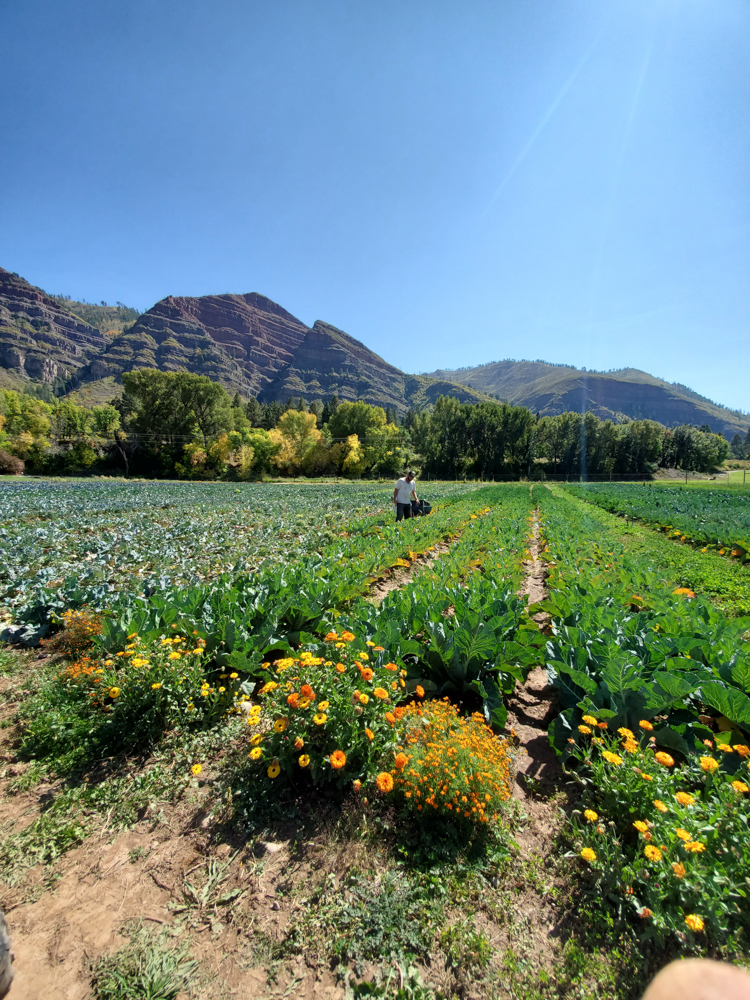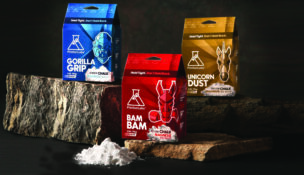Agriculture Report: Breaking new ground
First-generation farmers and ranchers lured by lifestyle, opportunity
Mike Taylor //September 3, 2021//
Agriculture Report: Breaking new ground
First-generation farmers and ranchers lured by lifestyle, opportunity
Mike Taylor //September 3, 2021//
It’s mid-May, and Max Fields is planting peas in the magnificent Animas Valley north of Durango. It’s a tedious task, done by hand, one seed per inch for 1,000 row feet. But there are perks, not least of which is working outdoors surrounded by the San Juan mountains of Southwest Colorado, and the satisfaction of working for oneself.
“Being able to reap the fruits of our labor is a huge thing for me,” Fields says. “You build something up every year, and you either see the success or you don’t. But if you’re good at what you do, then you do see success and you can look back on a lot of hard work and feel good about it.”
Fields and business partner James Plate are good at what they do. (And yes, Fields and Plate are their real names.) Friends since kindergarten, they are first-generation farmers and ranchers (they also raise sheep). Little if anything in their backgrounds suggested they’d pursue careers in agriculture, much less succeed at it. Both grew up in Denver, attended East High School and then enrolled at Fort Lewis College in Durango.

“James was studying agriculture when we first got here, and I started taking some ag classes,” Fields says. “We met some farmers and started farming with them and just kind of fell into it. We saw some gaps in what other farmers were doing in this area and felt like we had a good chance to fill those gaps. And we really have. We’ve become one of the more reliable organic farms and probably one of the larger small-scale organic farms in the area.”
Fields credits Beth LaShell, an instructor in the ag department at Fort Lewis College and current coordinator of Old Fort at Hesperus, the site of an ag incubator program where Fields and Plate got some early firsthand experience on how to run a farm and make it work financially.

Fields and Plate have operated Fields to Plate Produce since 2013. They’ve been on their current site in Animas Valley for four years where they lease 120 acres, 10 of which is used to grow certified organic vegetables, the rest for raising about 300 sheep and growing hay.
Their main crops are carrots, beets, parsnip, potatoes and winter squash. They also produce a lot of broccoli, cauliflower and cabbage. To compensate for a high-altitude (6,600-foot elevation) and a frost-free season of fewer than 100 days, most of the harvest takes place in the fall. Vegetables are kept in a cold-storage root cellar and sold throughout the winter. Fields and Plate, who both turn 30 this year, work with two wholesalers – one in Montrose, the other in Aspen – who distribute their produce throughout the Western Slope and as far east as Colorado Springs.

The business is profitable and continually evolving. This year, Fields to Plate Produce is experimenting with on-farm dinners. “We’re on the river, and we have all the farm-fresh ingredients,” Fields says. “We can butcher our own sheep and do a straight farm-to-table dinner experience. We’re doing it for friends and family now, to get it dialed in to the point where we can charge a premium for a ticket.
“We’re always reinvesting,” Fields continues. “We only have one employee, so we’re just trying to make our processes as efficient and mechanized as possible so we don’t necessarily have to hire a whole lot more people to maintain a productive farm.”
Breaking Barriers
Colorado is among the top states for first-generation farms and ranches, with 31% of ag operations categorized as “beginning” producers. That makes Colorado tied for fifth among all states for percentage of farms and ranches in the state that are startups.
Kate Greenberg worked with young and first-generation farmers and ranchers all over the West before being appointed Colorado Commissioner of Agriculture two years ago, and she continues to work with them. What attracts someone to this life?
“A lot of the commonalities I’ve seen over the years are the desire to run your own business, basically to be your own boss; and a desire to not just know where your food comes from but be the one who’s growing and raising your own food and the food for your community,” Greenberg says. “A lot of the first-generation producers I’ve worked with are actually multi-generation producers who have skipped a generation or two. So a lot of them can remember grandparents who had farms or ranches or stories of their families’ farms or ranches. And they’re looking to get back, not to what it was, but back to a sense of that connectedness with the ground, with the earth, with the natural world and all the factors that allow us to eat on planet Earth.”
But the barriers to making a living off the land can be steep. “The top barrier across the country, including Colorado, for first-generation producers, is access to land and capital,” Greenberg says. “And access to land is typically a capital question – having the cash to buy the land. Those are challenges we’ve faced for a long time, and we’re not seeing substantial alleviation, just based on the market for land in Colorado. But there are efforts, certainly at the policy level, to try to alleviate some of that. I think beyond that, training and education is often a barrier. There are ways to minimize that barrier. We’re trying to do that with our ag workforce development program, which is a paid apprenticeship program. So they actually get their hands dirty on an ag operation, and then they can say after a six- or nine-month internship, ‘Actually this isn’t for me; I’m going to do something else,’ or they can say, ‘Oh, man, this is absolutely for me, and now I have an “in” with an ag family or an ag business, and I have a resource hub where I can access more tools for taking the next steps.’”
From Film Maker to Western Slope Orchardist
Harrison Topp and his wife and partner, Stacia Cannon, own and operate Topp Fruits, a 40-acre certified organic orchard operation divided between 15 acres in Paonia and 25 acres in Hotchkiss. As with Fields and Plate, there was nothing in Topp’s upbringing that would have suggested a livelihood in farming. He grew up in Evergreen, then attended New York University, graduating in 2009 with a double major in film and television production and anthropology.

He then spent three years working on a film project in Western North Carolina about Appalachian culture that resulted in the feature-length film, “If I had Wings to Fly.” It was during that immersion in agrarian culture that he became interested in farming as a livelihood.
“I love the intersectionality of agriculture,” Topp says. “I love how agriculture exists at the intersection of the environment and the economy and society and culture, and simultaneously you can hop in a new GPS-driven tractor, yet use a shovel that your great-great-great grandpa used. We’re first-generation, but for most people, farming contains both this incredible heritage and tradition as well as this very modern future. It’s an extremely intersectional industry, and I think I’ve always loved the opportunity and challenge that provides.”
Topp spent a few years farming mostly vegetables for a CSA (Community Supported Agriculture) in North Carolina before returning to Colorado and making plans for cultivating the 15-acre orchard in Paonia that his family owned but was not operating. The tenants who were leasing the property were going to be vacating it, making it available to Topp. His first harvest in 2013 was a success. But farming fortunes are nothing if not fickle. The next year, a spring freeze hit just as his trees were in full bloom, ruining his crop.
Still, he says, “There’s a lot of things about orcharding that I realized are really advantageous, including our ability to participate in federal programs.” Among them: “Loan programs, resource management programs. Those became accessible to me with a slightly more to-scale commercial orchard than when I was doing the smaller-scale vegetable growing.”
Topp explains that while 40 acres would be very small for a commodity vegetable operation or livestock ranch, it’s about mid-scale for a commercial orchard.
He continues, “And beyond the logistical pieces of it, once I really learned what it was like to grow a fresh, wonderful juicy peach and see other people eat that and enjoy it, there was nothing else that felt that good. It was just the most fun thing in the world to grow.
“It’s a rewarding but extremely challenging enterprise,” he says. “But one that we’re really dedicated to. We’re dedicated to being a part of the food system.”

Topp and Cannon both have jobs off the farm. Topp works full-time as membership director of the Rocky Mountain Farmers Union; Cannon is on the board of directors for the Delta Montrose Electric Association.
Asked how his education at NYU has come into play in agriculture, he says, “I think the thing that has translated from film school, both to the farm and to my work at the farmers union, is developing a vision and having the project-management skills to execute that vision. When we made our film in Western North Carolina, we worked with 50 to 100 volunteers and cast. If I took away anything from my experience learning how to make films, it’s about how to realize the final vision of a project. There’s the creative side and there’s the project-management side. And I’d like to think I bring a little bit of both of those to what I do. You definitely need the ability to work with people, the ability to work in systems, the ability to coordinate and plan projects.”
Topp, 34, has no shortage of reasons why farming appeals to him. One is family. Topp’s parents are both actively involved in the operations; his brother is a part-owner.
“We’re running the farm as a business, we’re running it for the values we want to bring to agriculture and our food system,” Topp says. “But also, though it’s not the purpose of the farm, we’ve learned that the farm really challenges us to have a deeper and more important relationship.”
Pueblo Enterprise Started as Teen
Shane Milberger’s start in commodity agriculture began in 1986 when he was a 17-year-old high school student. Encouraged by his father, he leased several acres from a neighbor, grew vegetables on it and soon after that, bought a small tractor.
“We grew everything you’d see at a farmers market or flea market, because that was where I sold them,” Milberger says.
Today, Milberger Farms encompasses 280 acres, much of it certified organic, on St. Charles Mesa near Pueblo. Milberger likes to say that his crops span the alphabet from asparagus to zucchini, but his specialty crops are pinto beans and a variety of chiles.
His primary customers are produce markets, restaurants, retail grocery stores throughout Colorado, wholesale produce distributors and commercial food manufacturers.

In 2009, Milberger and son Dalton opened a small produce stand on Business U.S. 50, east of Pueblo. Over time, they built that into a deli-style restaurant with a salad bar and bakery.
The latest development on the farm is a line of fire-roasted chiles, vacuumed packed and flash-frozen in a commercial processing plant built specifically to process chiles throughout the harvest season.
Milberger runs the farm and the store (including the restaurant) as separate businesses. The store employs 25 people at its peak.
“On the farm, if we could find them, we would employ up to about 35 people,” Milberger says. “But at the moment we only have 20 people, and we’re actually short-staffed. We can’t keep up with the harvest at the moment.”
Milberger says in his younger years he was running with the wrong crowd. He credits his father for steering him away from that, toward agriculture.
“The group of guys I was running around with – three of them ended up in prison out of the four of them,” Milberger says. “I always have to show my dad gratitude for seeing what was going on. He sort of pushed me into farming. What it did was allow me a lot of freedom. More freedom than what a 17-year-old should have. On the other hand, it gave me a lot of responsibility. And I enjoyed it. The older guys who ran all the roadside stands actually took me in under their arms and kicked me in the ass when I needed it and told me I did a good job when I did. And they sort of helped me out with marketing some of my products, telling me why I shouldn’t have grown this and why I should have grown something else.”
Asked to assess the current state of farming, Milberger responds, “It’s just really a tough game. I was raised not to give up. I should have given up farming two or three times, but I just couldn’t do it. And I’m glad I didn’t.”
Milberger’s son Dalton, now 24, is interested in continuing the family farming tradition that Milberger started.
Asked if he still sees farming as an attractive livelihood, Milberger says, “Half the time yes and half the time no. It is a good career. It’s fun. You’re with your family. His (Dalton’s) wife is our bookkeeper. He had a son a couple years ago, and now he’s on the farm every day, running around. You can’t go get a job and have your family with you like that. So for those benefits, it’s awesome, it’s great. My other son runs my store. Financially, it’s very stressful and very hard. We worked our tail off this spring; we’ve got our crops ready to go. They’re ready to harvest and I can’t find enough people to harvest. So we’ve actually abandoned part of our fields already that should have been harvested. It’s sort of heartbreaking because we worked so hard to get this ready to go, and it’s a beautiful crop – asparagus. It’s a very hot commodity. Everybody wants it. That’s why we grow it, because we can sell it. And we couldn’t because we didn’t have the help.”
Sarah Gleason: Marketing Guru-Turned Bison Rancher
After 10 years as a marketing specialist for companies that included Whole Foods and the Savory Institute, Sarah Gleason got into bison ranching full-time a little more than a year ago. At the Boulder-based Savory Institute, she worked with farmers and ranchers worldwide and learned about regenerating grasslands through holistic land management. Now she’s one of those ranchers.
Located 15 miles southwest of Durango, Gleason Bison is a holistically managed, grass-fed bison operation. “Our desire is to weave together the relationship between the animals, the environment and the community resulting in an intimate knowledge of where your meat comes from and the essential role the animals play in creating a healthy ecosystem,” says Gleason, 35.
Gleason Bison operates on just under 900 acres. Gleason has a 10-year lease on the property, with a right of first refusal if the owners decide to sell it.
As with other first-generation farmers and ranchers profiled here, there was little if anything in Gleason’s upbringing to indicate she’d develop an interest in working on the land. A Division I athlete, Gleason swam for Texas Christian University and earned a degree in political science. She grew up in Colorado Springs where here father was a health-care executive. Her father-in-law is a lawyer, and her husband is a physician. “I’d have to go back generations to find the last farmer or rancher in my family,” she says.



























